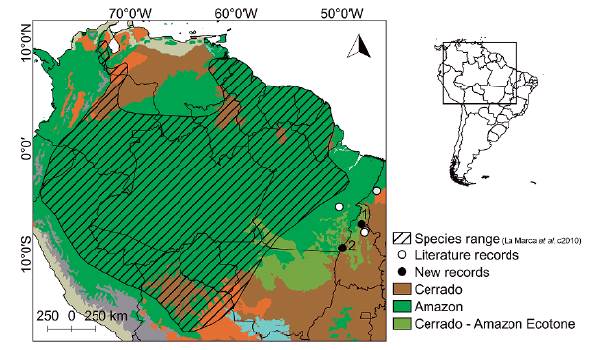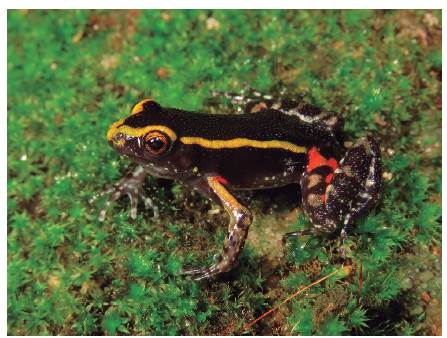Notas breves
New records of Lithodytes lineatus (Anura: Leptodactylidae) in the Cerrado-Amazon transition
Nuevos registros de Lithodytes lineatus (Anura: Leptodactylidae) en la transición Cerrado-Amazonas
Rafaela Thaler1
*
Henrique Folly2
Renata Fadel1
Leandro Alves-Da-Silva3
Sarah Mângia1
Diego José Santana1
1 Laboratório de Zoologia, Universidade Federal de Mato Grosso do Sul, 79002-970, Campo Grande, MS, Brazil, fadel. renata@yahoo.com.br, sarahmangia@yahoo.com.br, santanadiegojose@yahoo.com
2 Pós-graduação em Biologia Animal, Universidade Federal de Viçosa, 36570-000, Viçosa, MG, Brazil. folly.henrique@gmail.com
3 Pós-Graduação em Ciências Biológicas - Concentração em Zoologia, Universidade Federal da Paraíba, 58051-900, João Pessoa, PB, Brazil. leandro.herpeto@gmail.com
ABSTRACT
Lithodytes lineatus is widely distributed in the Amazon and currently found in the Cerrado domain. We document two new records of the species in the transition zone of Amazon-Cerrado located in the state of Tocantins, Brazil. These records extend the geographic distribution of this species and help to fill information gaps in the state of Tocantins, Brazil.
Keywords: Ecotone zone; geographic distribution; gold-striped frog
RESUMEN
Lithodytes lineatus tiene amplia distribución en el dominio amazónico y actualmente se encuentra en el dominio Cerrado. Documentamos dos nuevos registros de la especie en la zona de transición de Amazon-Cerrado ubicada en el estado de Tocantins, Brasil. Estos registros extienden la distribución geográfica de esta especie y ayudan a llenar los vacíos de información en el estado de Tocantins, Brasil.
Palabras clave: Distribución geográfica; rana terrestre rayada; zona ecotónica
Lithodytes lineatus (Schneider, 1799) is a monotypic species of the genus Lithodytes, commonly known as Gold-striped frog (Frank and Ramus 1996). This is a widely distributed species throughout the Amazon domain, and can also be found in transitional areas between the Amazon and Cerrado domains (La Marca et al. c2010, Valdujo et al. 2012, Cintra et al. 2014). In Brazil, L. lineatus occurs in the states of Acre, Amazonas, Pará, Rondônia, Mato Grosso, Tocantins, Maranhão, and Amapá (Pavan 2007, La Marca et al. c2010, Cintra et al. 2014, Freitas et al. 2014).
Here we provide new distribution records for L. lineatus in the Tocantins state, northern Brazil (Fig. 1). We obtained the new records during herpetofaunal studies in the Ara-guaia-Tocantins hydrographic basin, a transitional area between Amazonia and Cerrado. We captured individuals of L. lineatus (Fig. 2) using pitfall traps (collecting permit issued by IBAMA: 63228-1), and deposited the specimens in the Coleção Zoológica da Universidade Federal de Mato Grosso do Sul, Campo Grande municipality, Mato Grosso do Sul state, Brazil. To create the distribution map, we use the ecoregions shapefile from World Wild Life - WWF (Olson et al. 2001) modified to display the Brazilian domains highlighting the Ecoregion "Mato Grosso tropical dry forests" usually named as "Cerrado-Amazon ecotone" (e.g. Bezerra et al. 2009, Cintra et al. 2014). We used the International Union for Conservation of Nature - IUCN spatial data with the proposed L. lineatus distribution (La Marca et al. c20l0). Then, we added literature records from Tocantins (Pavan 2007, Cintra et al. 2014 and present study), Maranhão (Freitas et al. 2014) and Pará state (Bernardo et al. 2012). There is no information about Lithodytes lineatus type locality; thus, we expanded its distribution based on the nearest known locality for the species.
In March 2016, we collected two individuals of L. lineatus in Araguaína municipality (vouchers ZUFMS-AMP 08393 and 08394), northern Tocantins (7°6'17.03'' South; 48°11'23.32" West). This record extends the geographic distribution of L. lineatus approximately 79 km northwest from the nearest locality, Filadélfia municipality, Tocantins state, Brazil (Cintra et al. 2014) (Fig. 1).
In January 2017 and May 2018, we found six individuals of L. lineatus in Caseara municipality (vouchers ZUFMS-AMP 11243-11246), western Tocantins (9°24'25.36" South; 49°58'21.33" West). The records of L. lineatus to the Caseara municipality extend its distribution in approximately 280 km south-west from the previously southernmost locality in the state, reported from Palmeirantes municipality (Pavan 2007) (Fig. 1).
The data presented here on the geographic range of L. lineatus south into the Cerrado show that this species does not occur exclusively in the Amazon domain, reaching transitional areas and forest habitats in the Brazilian Cerrado. This result reinforces the species structure demonstrated by Valdujo et al. (2012) that Amazonian species of marginal occurrence in the Cerrado are concentrated in the western and northern of this domain. Despite harboring a unique anuran species composition comprised of species typical to the Cerrado and neighboring domains (Amazonia and Caatinga; Silvano et al. 2016), the Brazilian state of Tocantins still has many gaps of knowledge related to biodiversity and distribution patterns of anurans (Diniz-Filho et al. 2005). Additional sampling effort and new records will help to fill these gaps and improve strategies for conservation of biodiversity in this anuran species-rich region of northern Brazil.
ACKNOWLEDGMENTS
RT thanks to Conselho Nacional de Desenvolvimento Científico e Tecnológico - CNPq for the master fellowship (133289/2019-2). RMF thanks to Comitê de Aperfeiçoamento de Pessoal de Nível Superior - CAPES for the master fellowship (financing code 001). LAS thanks to CNPq for the doctoral fellowship (140408/2018-5). SM thanks to CAPES for the postdoctoral fellowship and DJS thanks to CNPq (311492/2017-7).
LITERATURE CITED
Bernardo PH, Guerra-Fuentes RA, Matiazzi W, Zaher H. 2012. Checklist of amphibians and reptiles of Reserva Biológica do Tapirapé, Pará, Brazil. Check List 8(5)839-846. doi: https://doi.org/10.15560/8.5.839.
[ Links ]
Bezerra AMR, Carmignotto AP, Rodrigues FHG. 2009. Small non-volant mammals of an ecotone region between the Cerrado hotspot and the Amazonian rainforest, with comments on their taxonomy and distribution. Zool. Stud. 48(6)861-874.
[ Links ]
Cintra CED, da Silva HLR, Junior NJS. 2014. First record of Lithodytes lineatus (Schneider, 1799) (Anura: Leptodactylidae) in the state of Tocantins, ecotone zone Amazon-Cerrado biomes, with notes on its natural history. Herpetol. Notes. 7:179-184.
[ Links ]
Diniz-Filho JAF, Bastos RP, Rangel TF, Bini LM, Carvalho P, Silva RJ. 2005. Macroecological correlates and spatial patterns of anuran description dates in the Brazilian Cerrado. Global Ecol. Biogeogr. 14(5)469-477. doi: https://doi.org/10.1111/j.1466-822X.2005.00165.X.
[ Links ]
Frank N, Ramus E. 1996. A complete guide to scientific and common names of reptiles and amphibians of the world. Copeia 1996(4):1066-1069. doi: https://doi.org/10.2307/1447688.
[ Links ]
Freitas MA, Farias T, Sousa SO, Vieira RS, de Moura GJB, Dias IR. 2014. First record of Lithodytes lineatus (Schneider, 1799) (Anura: Leptodactylidae) in northeastern Brazil. Check List 10(3):615-617. doi: https://doi.org/10.15560/10.3.615.
[ Links ]
La Marca E, Azevedo-Ramos C, Coloma LA, Ron S, Hardy J. c2010. Lithodytes lineatus. Red List of Threatened Species 2010: e. T57177A11580398. [last accessed: 16 Jul 2018].
http://dx.doi.org/10.2305/IUCN.UK.2010-2.RLTS.T57177A11580398.en
[ Links ]
Olson DM, Dinerstein E, Wikramanayake ED, Burgess ND, Powell GVN, Underwood EC, D'Amico JA, Itoua I, Strand HE, Morrison JC, Loucks CJ, Allnutt TF, Ricketts TH, Kura Y, Lamoreux JF, Wettengel WW, Hedao P, Kassem KR. 2001. Terrestrial ecoregions of the world: a new map of life on Earth. Bioscience 51(11):933-938. doi: https://doi.org/10.1641/0006-3568(2001)051[0933:TEOTWA]2.0.CO;2.
[ Links ]
Pavan D. 2007. Assembleias de repteis e anfíbios do Cerrado ao longo da bacia do rio Tocantins e o impacto do aproveitamento hidrelétrico da região na sua conservação. [Thesis]. [São Paulo]. Universidade de São Paulo.
[ Links ]
Silvano DL, Valdujo PH, Colli GR. 2016. Priorities for Conservation of the Evolutionary History of Amphibians in the Cerrado. In: Pellens R, Grandcolas P, editors. Biodiversity Conservation and Phylogenetic Systematics. Springer, Cham. p. 287-304.
[ Links ]
Valdujo PH, Silvano DL, Colli G, Martins M. 2012. Anuran species composition and distribution patterns in Brazilian Cerrado, a Neotropical hotspot. South Am J Herpetol. 7(2)63-78. doi: https://doi.org/10.2994/057.007.0209.
[ Links ]
















